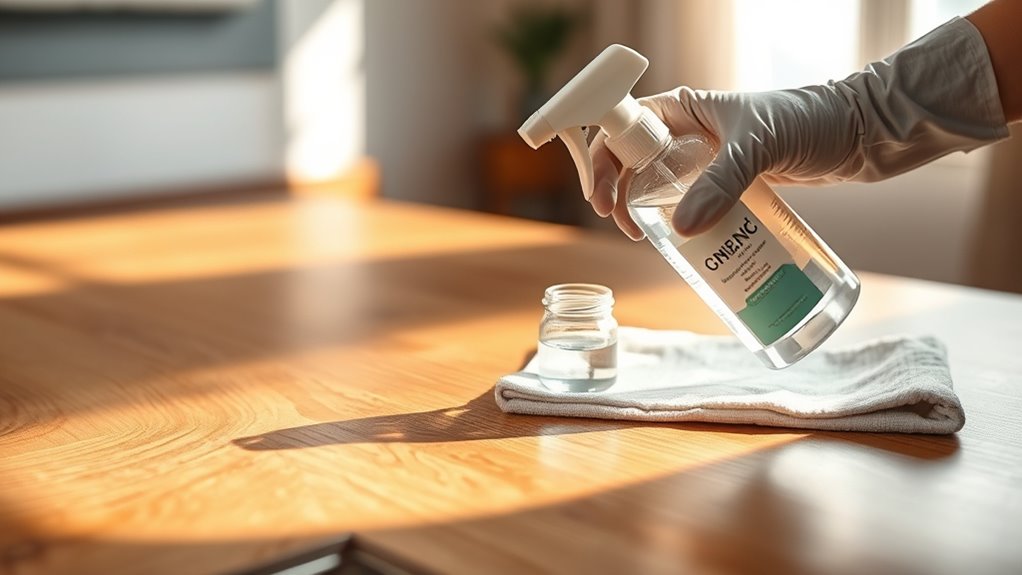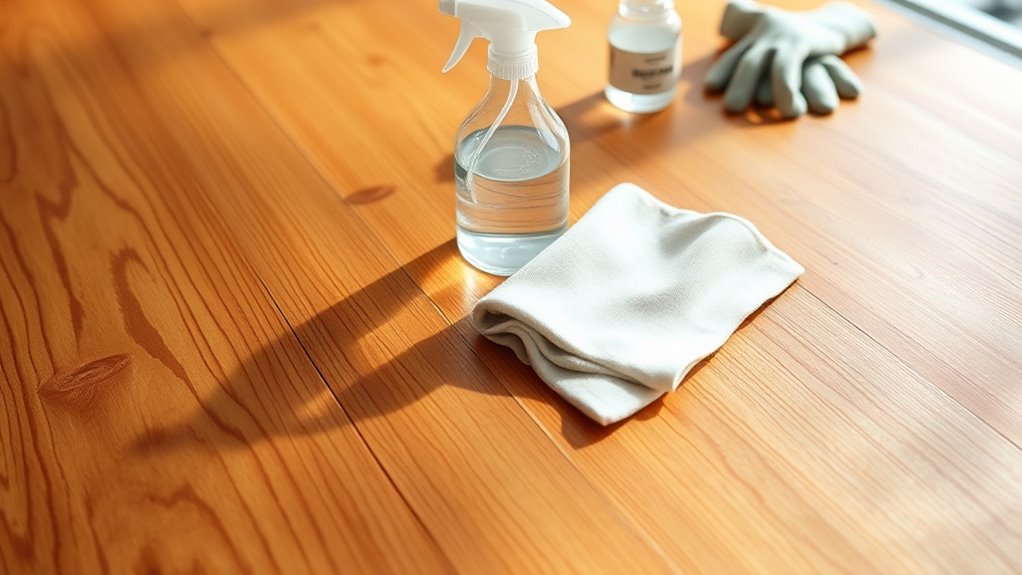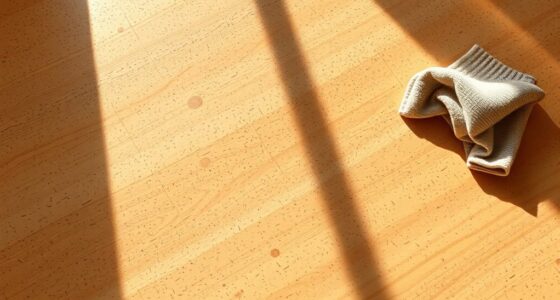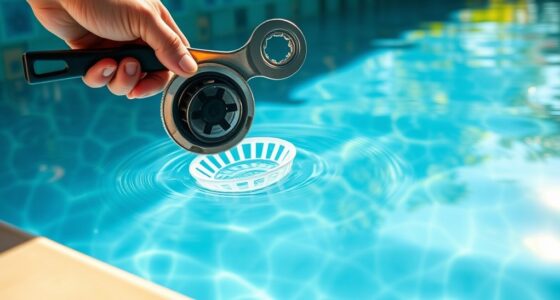To disinfect engineered wood safely, you should opt for UV-C light and natural disinfectants like vinegar, lemon juice, or tea tree oil, which kill germs without damaging the surface. Avoid harsh chemicals such as bleach or ammonia, as they can cause long-term damage or discoloration. Make sure to follow product instructions and conduct a patch test first. If you keep exploring, you’ll discover more effective techniques to keep your surfaces clean and protected.
Key Takeaways
- Use UV-C light and natural disinfectants like vinegar or lemon juice for chemical-free cleaning.
- Avoid harsh chemicals such as bleach or ammonia, which can damage engineered wood surfaces.
- Always follow manufacturer instructions and perform patch tests before applying any disinfectant.
- Keep surfaces dry and prevent excessive moisture to avoid warping or long-term damage.
- Combine UV sterilization with gentle natural cleaners for effective, safe disinfection practices.

Engineered wood surfaces can harbor germs and bacteria, making regular disinfection essential for maintaining a healthy environment. When it comes to disinfecting these surfaces, it’s important to choose methods that are both effective and safe for the material. One option gaining popularity is the use of UV light. UV-C light, in particular, has proven to be a powerful disinfectant because it destroys the DNA of bacteria and viruses, rendering them inactive. You can find UV sterilizers or lamps designed specifically for household use, which can quickly disinfect engineered wood surfaces without the need for chemical cleaners. Just be sure to follow the manufacturer’s instructions carefully, as improper use may reduce effectiveness or damage the surface.
UV-C light effectively disinfects engineered wood surfaces without chemicals when used properly.
In addition to UV light, utilizing natural disinfectants can be a safer alternative to harsh chemicals. Vinegar, for instance, is a natural antimicrobial that can effectively reduce bacteria on engineered wood when used properly. A mixture of equal parts water and vinegar can be applied with a soft cloth to clean the surface thoroughly. Lemon juice and tea tree oil are other natural options with antimicrobial properties. These natural disinfectants are gentle on the environment and less likely to cause damage or discoloration to the engineered wood compared to chemical-based cleaners. However, avoid saturating the surface with excess liquid, as moisture can seep into the material and cause warping or swelling over time.
You should also be cautious about what disinfectants to avoid. Many commercial disinfectants contain harsh chemicals like bleach or ammonia, which can degrade the finish or damage the engineered wood if used excessively or improperly. These chemicals can also leave residues that might be harmful, especially in homes with children or pets. Always check the product labels and opt for disinfectants that specify compatibility with wood surfaces. If you’re unsure, test a small, inconspicuous area first to see if there’s any adverse reaction before proceeding with full cleaning.
Ultimately, the safest and most effective way to disinfect engineered wood is by combining methods. Use UV light regularly to kill germs without chemicals, and supplement with natural disinfectants for routine cleaning. Keep the surface dry and avoid abrasive tools that could scratch or damage the finish. By choosing the right disinfectants and techniques, you’ll maintain a healthier environment while preserving the integrity of your engineered wood surfaces. Incorporating appropriate cleaning methods can also help extend the lifespan of your surfaces and prevent long-term damage.
Frequently Asked Questions
Can I Disinfect Engineered Wood With Household Bleach Safely?
You can’t safely disinfect engineered wood with household bleach because it may damage the material. Bleach isn’t compatible with engineered wood’s finish and can cause discoloration or warping. Instead, opt for gentler disinfectants like diluted vinegar or alcohol-based solutions, which are safer for material compatibility. Always test a small, hidden area first, and follow manufacturer guidelines to keep your engineered wood in good condition.
How Often Should I Disinfect Engineered Wood Flooring?
You should disinfect your engineered wood flooring at least once a week—more if you have pets, kids, or lots of visitors. This cleaning frequency keeps germs at bay and maintains surface beauty. Regular surface maintenance prevents dirt from turning into stubborn grime and keeps your floors shining like a mirror. Don’t slack off; consistent disinfecting is essential for a healthy home, making your space feel fresh and protected every single day.
Are There Natural Disinfectants Suitable for Engineered Wood?
Yes, there are natural alternatives suitable for disinfecting engineered wood. Eco-friendly solutions like diluted white vinegar or rubbing alcohol can effectively disinfect without harming your flooring. Just make certain you use them in moderation and avoid harsh chemicals. Always test a small, hidden area first to prevent damage. These natural disinfectants provide a safe and effective way to keep your engineered wood clean while minimizing environmental impact.
Will Disinfectants Damage the Finish of Engineered Wood?
You might wonder if disinfectants will damage your engineered wood, and the answer is yes—some can harm the finish. Harsh chemicals can cause unwanted chemical reactions, dulling or peeling the protective layer. To preserve your finish, choose gentle, pH-neutral disinfectants and avoid strong cleaners. This way, you protect your wood’s appearance while keeping it hygienic, ensuring it stays beautiful for years to come.
Is Steam Cleaning Safe for Disinfecting Engineered Wood Surfaces?
Steam cleaning can be safe for disinfecting engineered wood surfaces if done carefully. The heat from steam acts as a form of heat disinfection, killing germs effectively. However, you should avoid excessive moisture and prolonged exposure, as too much heat or water can damage the finish or warp the wood. Always use a low or moderate steam setting and keep the steam moving to prevent damage.
Conclusion
To keep your engineered wood safe and clean, use gentle disinfectants like diluted vinegar or alcohol-based solutions, and avoid harsh chemicals that can damage the surface. Did you know that over 70% of household disinfectants contain chemicals linked to health issues? By choosing safe, effective products, you not only protect your furniture but also your family’s health. Stay informed and disinfect wisely to enjoy beautiful, lasting engineered wood for years to come.









